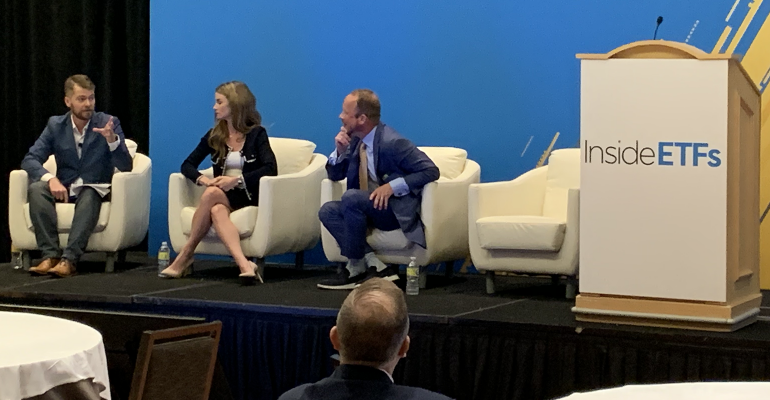The growing market for active ETFs was a prominent theme at the recent Inside ETFs Conference held in Hollywood, Fla., and while there were plenty of issuers on hand discussing the benefits, it remains to be seen if advisors will be as receptive.
Even though actively managed exchange-traded funds have been around for more than a decade, they’ve only started to garner attention from a wider group of asset managers and ETF issuers over the past two years hopeful the wrapper will give more advisors access to their investment strategies.
Asset growth, however, trails the growth in funds. Currently, active ETFs make up 30% of the 3,021 U.S. ETF funds, but hold only 5% of the total investments, according to Morningstar.
The pivot toward active ETFs is partially due to the saturation in index-based passive funds, as well as active strategists looking stem the outflows from their higher-priced, active mutual funds. Yet many are using the active ETF structure to create more thematic investment portfolios that don’t hew to traditional style-box portfolios; that may bring advisors unique access to certain corners of the market, but begs the question of how these funds are meant to be judged.
In 2020, 175 active ETFs launched for a total $181.3 billion in assets under management by the end of that year. Last year, saw 298 active ETFs launched, a 70% increase, lifting total active assets 61% to $292.7 billion. This year has seen the launch of 99 active ETFs, compared to only 67 passive ETFs. Total active ETF assets as of May 31 was $311.5 billion, according to Morningstar.
Several speakers pointed to the obvious benefits of the ETF wrapper over mutual funds, including lower costs, greater tax efficiency, more flexibility and cheaper to trade.
Steve Cook, managing director of ETFs at Harbor Capital Advisors, reminded advisors that mutual funds get clocked with capital gains when investors sell shares, leaving those who remain with capital gains taxes.
“Because ETFs avoid capital gains distributions, the ETF investor won’t get socked with a 15% capital gains bill when other investors sell,” said Cook.
That’s particularly painful when markets go lower. “In mutual funds you are impacted by the activity of other investors. In a down year, you could still have capital gains,” said Rafia Hasan, chief investment officer for Wipfli Financial Advisors. “When markets are down, investors do tax loss harvesting which exacerbates the tax inefficiency situation in a mutual fund.”
Some advisors perceive the lower trading volume of active ETFs as a liquidity concern, said Matt Lewis, head of ETFs at American Century. But that’s misplaced.
“It just means it hasn’t traded as much as a passive ETF,” said Lewis. “What really matters is the liquidity of the underlying stocks in the ETF.”
Yet while the ETF structure has benefits over mutual funds, managers still face the issue of convincing advisors that active strategies can deliver returns above lower-cost passive portfolios. According to the S&P Index vs. Active (SPIVA) scorecard, the oft-cited S&P Dow Jones Indices report, only 11% of all domestic active equity funds beat their benchmark over a 10-year period in terms of absolute returns. Of the 15 mutual funds on Harbor Capital’s website, 40% report beating their benchmark over 10 years.
Most active managers issuing ETFs aren’t replicating traditional style-box investment strategies, and yet those benchmarks are often how their performance is judged by research firms and institutional investment committees.
“Clients don’t care about benchmarks. The reason a lot of managers don’t beat their benchmarks is because they’re not trying to,” said Robert Isbitts, co-founder and chief investment strategist for Sungarden Investment Publishing.
Harbor Capital issued three active ETFs over the past year, including the Harbor Corporate Culture Leaders ETF (HAPY) meant to invest in firms with “strong corporate cultures.”
“All our products will deliver idiosyncratic returns,” said Cook. “We have concentrated portfolios with between 35-70 stocks. We’re not benchmark cutters. We’re not afraid of transparency. So we are going to deliver those portfolios in a transparent active ETF wrapper. You know what you own and I think the advantage is, longer return, being able to deliver true idiosyncratic alpha over a typical benchmark.”
Lewis acknowledged the problem: “Active ETFs do have a benchmark, but it’s really what is the strategy trying to do in the portfolio and does it fit that for you. The fund might not beat the benchmark, but is it meeting the goals of the portfolio allocation and is it matching against the strategy that you researched and want to be a part of. We’re trying to beat the benchmarks, but ultimately it comes down to, does the strategy fit your investment goals.”
“I would say the investor’s toolbox is getting bigger and bigger,” said Dodd Kittsley, national director at Davis Advisors, one of the first active managers to put their strategies in transparent ETFs. “For active equity ETFs, I think we’re just in the first inning of potentially an extra-inning ballgame. This is ETFs 4.0, and it will be the ETF industry’s engine of growth going forward for a lot of reasons. Everyone equates equity ETFs with indexing. But it’s not that. ETFs are really about getting a more efficient exposure. It can be indexes, rules-based indexes, or it can be judgement, discretion and experience that add a tremendous amount of value.”





